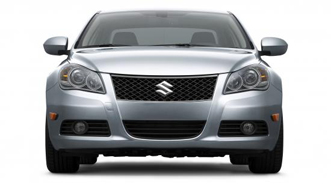NADA UCG Gauges How Far Suzuki’s Used-Car Values Have Dipped

By subscribing, you agree to receive communications from Auto Remarketing and our partners in accordance with our Privacy Policy. We may share your information with select partners and sponsors who may contact you about their products and services. You may unsubscribe at any time.
McLEAN, Va. –
Since American Suzuki Motor Corp. officially received confirmation of its bankruptcy plans last week, NADA Used Car Guide decided to reexamine how values of this OEM’s vehicles are trending nowadays.
Analysts decided to focus on one specific model to get a hold of the situation and found the 2010 Suzuki Kizashi S sedan provided some clarity. They pegged the Kizashi against some of its closest competitors to determine benchmark movement.
Since October, analysts noticed the Kizashi’s trade-in value fell from $10,800 to $9,225 in March, which is a loss of $1,575, or 14.6 percent. NADA UCG indicated values for most other models in this competitive set have remained relatively flat or have even appreciated a bit as in the case of the Nissan Altima and Toyota Camry.
To illustrate this, NADA Used Car Guide offered the following chart in a blog post:
| Year | Make | Model | TE MSRP |
10/2012 Avg. Trade |
3/2013 Avg. Trade |
Pct. Change |
| 2010 | Suzuki | Kizashi SE 2.4L I4 | $21,599 | $10,800 | $9,225 | -14.6% |
| 2010 | Chevrolet | Malibu LT 2.4L I4 | $22,715 | $11,525 | $11,100 | -3.7% |
| 2010 | Ford | Fusion SE 2.5L I4 | $22,100 | $11,597 | $11,572 | -0.2% |
| 2010 | Nissan | Altima S 2.5L I4 | $21,840 | $12,090 | $12,225 | +1.6% |
| 2010 | Toyota | Camry LE 2.5L I4 | $21,900 | $12,012 | $12,187 | +1.5% |
“Clearly the bankruptcy announcement has had an extremely corrosive effect on the Kizashi’s values,” NADA Used Car Guide executive automotive analyst Jonathan Banks wrote in his blog entry post dissecting Suzuki values.
Banks explained the closest comparison he can make to Suzuki’s is the recent dissolution of Saab, specifically the 9-3 sedan.
Subscribe to Auto Remarketing to stay informed and stay ahead.
By subscribing, you agree to receive communications from Auto Remarketing and our partners in accordance with our Privacy Policy. We may share your information with select partners and sponsors who may contact you about their products and services. You may unsubscribe at any time.
From November 2011 through April of last year, Banks said the 9-3 depreciated by 10.5 percent. And by November of last year, the unit had lost 30.5 percent of its pre-bankruptcy value.
“It’s still a bit too early to predict just how low Suzuki’s values will go, but based on the severity of movement observed to date and how far values for comparable vehicles fell in the past, we can safely assume that the bankruptcy-induced floor has yet to be reached,” Banks said.
Earlier in his commentary, Banks delved into how Suzuki landed in bankruptcy. Banks highlighted the automaker’s new-model sales were steadily improving throughout the early part of the last decade before peaking in 2007 when the brand sold more than 101,000 new units.
When that peak came, sales tailed off tremendously because of the 2008 recession.
Banks explained, “Suzuki, like many other manufacturers, suffered a huge blow to their sales momentum following the onset of the recession, but unlike larger OEMs, American Suzuki didn’t have the brand awareness or the capital required to successfully weather the global economic storm.
“Ultimately, sales fell by a staggering 62 percent in the two years following the onset of the recession before bottoming out in 2010 when they failed to cross the 24,000 unit threshold,” he continued.
“Just when things couldn’t get any worse for the brand, in 2011 Suzuki was dealt another devastating blow as the Japan earthquake spawned a chain of production related disruptions,” Banks went on to note.
“Last year will be known as the last full sales year for Suzuki here in the U.S., and another in which the brand saw little to no growth with sales barely crossing the 25,000 unit threshold,” Banks added. “Overall, depressed market conditions, natural disasters, poor brand recognition, and lack of funds for new products were the biggest drivers behind Suzuki’s demise in the U.S.”
As a result, American Suzuki announced plans last November to file for bankruptcy. Then last week, Judge Scott Clarkson of the U.S. Bankruptcy Court for the Central District of California in Santa Ana approved the confirmation of the company’s Chapter 11 Plan, which officials said creditors overwhelmingly accepted.
That confirmation of the plan clears the way for Suzuki to complete its restructuring process, which is expected to occur on March 31.
As previously announced, the plan approved the company’s sale of its motorcycles/ATV and marine divisions and automotive parts and service operation to a newly organized, wholly-owned subsidiary of Suzuki Motor Corp. The subsidiary will operate in the continental U.S. as Suzuki Motor of America and will use the Suzuki products brand name
“The confirmation is a significant milestone and is one of the last remaining steps in our realignment and restructuring process,” said Freddie Reiss, the company’s chief restructuring officer.
“During the next few weeks, we will take final steps to implement the plan, which will allow the Company to sell its motorcycles/ATV, marine, automotive parts and service divisions,” Reiss continued. This will promote the long-term growth of the motorcycles/ATV and marine divisions, as well as providing automotive parts and service through the dealer network.”
A copy of the plan is available at www.omnimgt.com.
Additional information regarding the company’s business realignment can be found at www.suzuki.com or via an information hotline at (877) 465-4819.
Continue the conversation with Auto Remarketing on both LinkedIn and Twitter.


